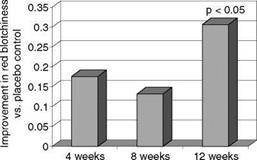The key challenge for working with niacinamide and nicotinate esters is avoiding hydrolysis to nicotinic acid. Nicotinic acid, even at low doses, can induce an intense skin reddening (flushing) response (30). While a little skin redness (increased skin “pinkness”) may be a
|
□ 5% niacinamide |
|
Figure 8 Niacinamide is well tolerated by the skin and even reduces facial skin red blotchiness. Subjects were female Caucasians (n = 50) who applied placebo control versus 5% niacinamide formulations to their faces (12-week, double-blind, split-face, left-right randomized clinical trial). |

desired effect, the flushing response among individuals is highly variable in terms of dose to induce it, time to onset of the response, and duration of response. Additionally, the flushing can also have associated issues such as burn, sting, and itch, particularly under cold and/or dry conditions. To avoid hydrolysis, formulating in the pH range of 5 to 7 is preferred. This flushing issue also requires that the purity of the raw material (e. g., niacinamide) be very high to minimize any contaminating free acid.
For the nicotinate esters, there are many commercial options. Many of them unfortunately are readily hydrolyzed to nicotinic acid on or in the skin such that flushing responses occur rapidly (within seconds/minutes) even at very low concentrations (< 1%). The longer chain esters (e. g., myristoyl-nicotinate) apparently are more resistant to this hydrolysis and thus appear to be more suitable for use topically.

